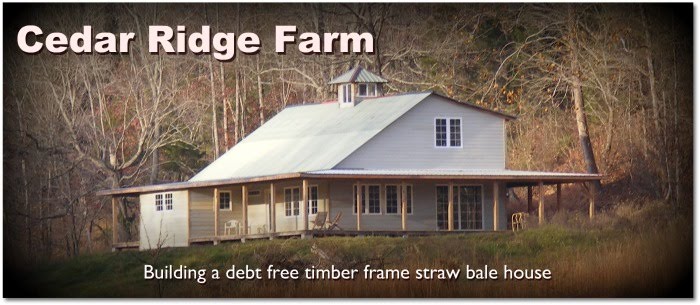Here it is almost five months since the frame raising and I still don't have the roof on the house. I wanted it on a long time before now. It just hasn't come together. The ceiling took a fair bit of work. If this project wasn't being done debt-free, then things would probably be done more quickly. As it is, I must invest a lot of labor in order to save money. That just takes time.
I talked with a friend of mine who is, among other things, an insulation specialist and consultant about my plans for insulating my roof. He's the same guy who is going to spray the ceramic coating
on my metal later. With his input, I decided to go with a 10" space for the insulation. He'll come down from where he lives in Indiana and dense pack cellulose insulation in the space sometime this spring or summer. It'll provide about an R-40 insulation value, plus it will effectively create an air-tight roof. There is much to be gained by air-tightness.
Once the bale walls are plastered, the rest of the home will be very close to air tight. This will be great for heating and cooling. However, careful consideration needs to be given to ventilation of the indoor space. With an air tight home, moisture and pollutants within the home can create problems; there needs to be some sort of ventilation plan. I will have lots of windows, and they will provide ventilation. But what about the times when I don't want the windows open? As I've contemplated the situation, I have had as one of my desires to design and install a system that can basically work without dependence upon outside power and limited input from me. Tough design criteria.
The main part of the plan I've developed so far involves a cupola in the center of the home at the peak of the roof (I guess a cupola pretty much goes at the peak). I have the parts of it ready to be installed. If the weather is good, I'll hopefully install it within the week. It will be approximately 4 feet by 4 feet. There will be windows on each side -- a 2'x3' on the front, a 2'x2' on the back, and a 2'x18" on each of the sides. The front and back windows will be rigged so that I can open and close them from inside the house below the cupola (since it would require a ladder to get into the cupola space). These windows in the cupola will provide ventilation using the natural chimney/convection effect the cupola will provide. Initially, the windows in the house will provide the air intake while the cupola works to exhaust air, controlled by how far the windows are opened.
Another aspect of the system which I will add at a later time is natural cooling for the house. This system will utilize the cupola and the stack effect it will create. Incoming air will be controlled through duct work that is connected to underground tubes through which the outside air will flow before entering the house. These tubes (nine 4" sewer pipes each with a run of 50'-75') will be buried about 4' in the ground where the temperature remains fairly constant (about 60 degrees). I'll see about drawing a diagram of this later. Because of the insulation value and tightness of the home, I expect that the constant flow of conditioned air introduced into the house through these tubes will not need to be that great. So, the system will help condition the air in the house at a comfortable level without any electricity needed. In the winter, the same system can be used to introduce air for ventilation that has been warmed by the earth.
The natural air conditioning aspect is still be developed in my head. The cupola, though, is nearly a reality. After I have it installed (without the windows), I'll get the roof put on. I have some friends who are going to help me with that soon.
Introduction
The 57 acres that comprise Cedar Ridge Farm are located in the beautiful rolling hills of South Central Kentucky. My wife, our four children, and I are on a homesteading adventure as we work toward increased self-sufficiency. We grow much of our own food and enjoy being in touch with the agrarian roots of our lives.
One of the major projects we have undertaken is the building of our own home. The house we're building has three major distinguishing features: 1. we're building it without incurring any debt; 2. it is a timber frame structure; and 3. the exterior walls will be plastered straw bales. We live debt and mortgage free, and building our house with that approach makes perfect sense. Large timbers in a home possess a beauty and project a sense of strength, stability, and warmth that we want in our home. Straw bale walls provide insulation and make ecological sense. This blog is a record of our home-building project.
One of the major projects we have undertaken is the building of our own home. The house we're building has three major distinguishing features: 1. we're building it without incurring any debt; 2. it is a timber frame structure; and 3. the exterior walls will be plastered straw bales. We live debt and mortgage free, and building our house with that approach makes perfect sense. Large timbers in a home possess a beauty and project a sense of strength, stability, and warmth that we want in our home. Straw bale walls provide insulation and make ecological sense. This blog is a record of our home-building project.
Wednesday, January 30, 2008
Update: the rest of the ceiling
I have been very negligent in taking care of my blog. It's kind of a slow time of year because of the weather and amount of daylight. These things have affected my work on the house. Also, as the year progressed, the amount of money in the house budget dwindled down to almost nothing. That certainly impacted what I've gotten done.
Prior to Thanksgiving I had as my goal the completion of the cathedral ceiling. I wanted it all on and at least some tar paper on top to keep out some of the water. So, I continued my working of the ceiling boards -- planing, cutting to length, edging, and rabbeting. I was able to get ceiling finished prior to the opening of modern gun season for deer here in my area (November 10th). Here are some photos I took just after finishing it:






Yeah, I could've added some more text. I'll do that on some other items soon. But for now, you can see the pictures.
Prior to Thanksgiving I had as my goal the completion of the cathedral ceiling. I wanted it all on and at least some tar paper on top to keep out some of the water. So, I continued my working of the ceiling boards -- planing, cutting to length, edging, and rabbeting. I was able to get ceiling finished prior to the opening of modern gun season for deer here in my area (November 10th). Here are some photos I took just after finishing it:






Yeah, I could've added some more text. I'll do that on some other items soon. But for now, you can see the pictures.
Subscribe to:
Posts (Atom)

